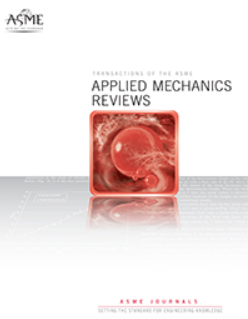Nanoparticle Size and Heat Pipe Angle Impact on the Thermal Effectiveness of a Cylindrical Screen Mesh Heat Pipe
IF 16.1
1区 工程技术
Q1 MECHANICS
引用次数: 1
Abstract
This study examines the effects of particle size and heat pipe angle on the thermal effectiveness of a cylindrical screen mesh heat pipe using silver nanoparticles (Ag) as the test substance. The experiment investigates three different particle sizes (30 nm, 50 nm, and 80 nm) and four different heat pipe angles (0°, 45°, 60°, and 90°) on the heat transmission characteristics of the heat pipe. The results show that the thermal conductivity of the heat pipe increased with an increase in heat pipe angle for all particle sizes, with the highest thermal conductivity attained at a 90° heat pipe angle. Furthermore, the thermal resistance of the heat pipe decreased as the particle size decreased for all heat pipe angles. The thermal conductivity measurements of the particle sizes—30, 50, and 80 nm—were 250 W/mK, 200 W/mK, and 150 W/mK, respectively. The heat transfer coefficient values for particle sizes 30 nm, 50 nm, and 80 nm were 5500 W/m2K, 4500 W/m2K, and 3500 W/m2K, respectively. The heat transfer coefficient increased with increased heat pipe angle for all particle sizes, with the highest heat transfer coefficient obtained at a 90° heat pipe angle. The addition of Ag nanoparticles at a volume concentration of 1% reduced the thermal resistance of the heat pipe, resulting in improved heat transfer performance. At a heat load of 150 W, the thermal resistance decreased from 0.016 °C/W without nanoparticles to 0.012 °C/W with 30 nm nanoparticles, 0.013 °C/W with 50 nm nanoparticles, and 0.014 °C/W with 80 nm nanoparticles. This study also found that the heat transfer coefficient increased with increased heat pipe angle for all particle sizes, with the highest heat transfer coefficient obtained at a 90° heat pipe angle.纳米颗粒尺寸和热管角度对圆柱筛网热管热效率的影响
本研究以银纳米颗粒(Ag)为测试材料,考察了颗粒尺寸和热管角度对圆柱形筛网热管热效率的影响。实验研究了三种不同粒径(30 nm、50 nm和80 nm)和四种不同热管角度(0°、45°、60°和90°)对热管传热特性的影响。结果表明:各粒径的热管导热系数均随热管角的增大而增大,在热管角为90°时,热管导热系数最高;此外,在所有热管角度下,热管的热阻随颗粒尺寸的减小而减小。粒径为30、50和80 nm时的导热系数分别为250 W/mK、200 W/mK和150 W/mK。粒径为30 nm、50 nm和80 nm时的换热系数分别为5500 W/m2K、4500 W/m2K和3500 W/m2K。传热系数随热管角度的增大而增大,在热管角度为90°时传热系数最高。体积浓度为1%的银纳米颗粒的加入降低了热管的热阻,从而提高了热管的传热性能。热负荷为150 W时,热阻从无纳米颗粒时的0.016°C/W下降到30 nm时的0.012°C/W, 50 nm时的0.013°C/W, 80 nm时的0.014°C/W。本研究还发现,对于所有粒径,传热系数随热管角度的增大而增大,在热管角度为90°时传热系数最高。
本文章由计算机程序翻译,如有差异,请以英文原文为准。
求助全文
约1分钟内获得全文
求助全文
来源期刊
CiteScore
28.20
自引率
0.70%
发文量
13
审稿时长
>12 weeks
期刊介绍:
Applied Mechanics Reviews (AMR) is an international review journal that serves as a premier venue for dissemination of material across all subdisciplines of applied mechanics and engineering science, including fluid and solid mechanics, heat transfer, dynamics and vibration, and applications.AMR provides an archival repository for state-of-the-art and retrospective survey articles and reviews of research areas and curricular developments. The journal invites commentary on research and education policy in different countries. The journal also invites original tutorial and educational material in applied mechanics targeting non-specialist audiences, including undergraduate and K-12 students.

 求助内容:
求助内容: 应助结果提醒方式:
应助结果提醒方式:


